Nursing Leadership: Addressing Issues at Calvary Hospital, Australia
VerifiedAdded on 2021/04/21
|9
|2607
|20
Essay
AI Summary
This essay delves into the critical role of leadership within the nursing profession, using Calvary Hospital in Canberra as a case study. It highlights the importance of leadership in guiding employees, fostering motivation, and ensuring ethical and efficient operations. The essay addresses a specific issue at Calvary Hospital involving the theft of sensitive documents, raising concerns about employee loyalty and security. It explores various leadership styles, including autocratic, democratic, laissez-faire, transformational, and transactional, and argues for the adoption of a democratic leadership style to promote employee responsibility and address the hospital's challenges. The essay emphasizes the need for effective leadership to maintain departmental cohesion, update record-keeping practices, and develop future leaders within the organization. Ultimately, it concludes that strong leadership is essential for organizational success and that a democratic approach can help Calvary Hospital overcome its current issues and build a more responsible and motivated workforce.
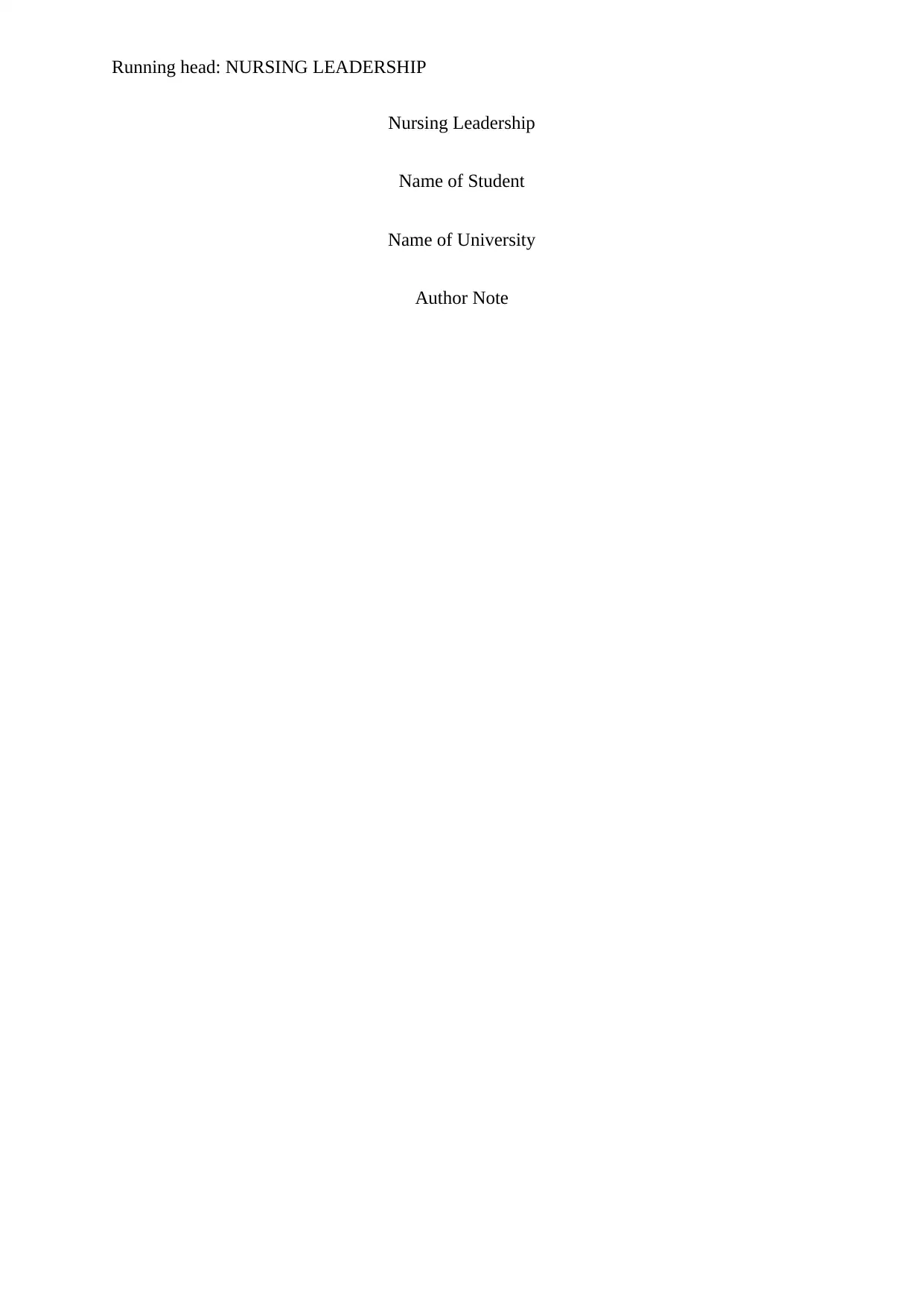
Running head: NURSING LEADERSHIP
Nursing Leadership
Name of Student
Name of University
Author Note
Nursing Leadership
Name of Student
Name of University
Author Note
Paraphrase This Document
Need a fresh take? Get an instant paraphrase of this document with our AI Paraphraser
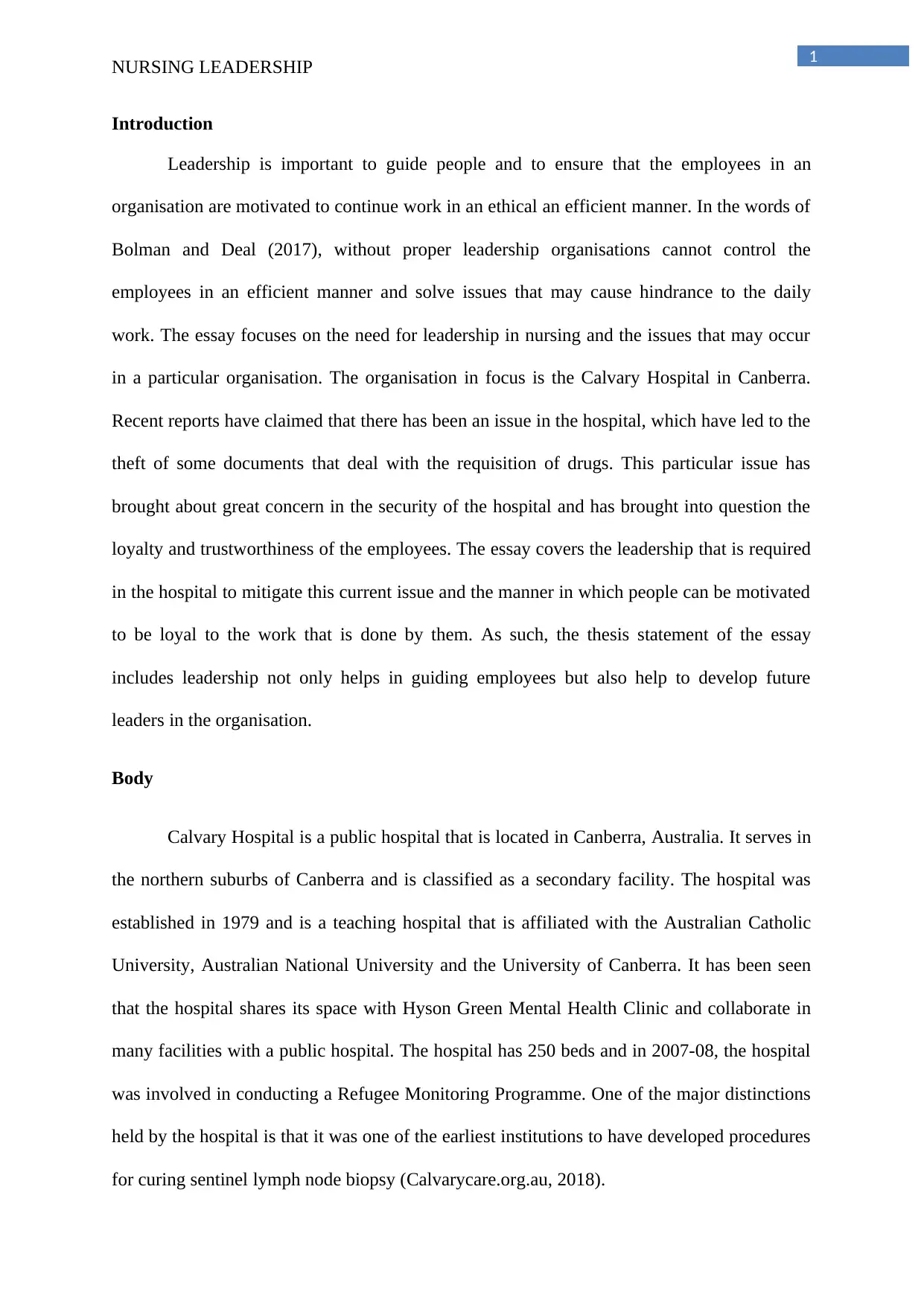
1
NURSING LEADERSHIP
Introduction
Leadership is important to guide people and to ensure that the employees in an
organisation are motivated to continue work in an ethical an efficient manner. In the words of
Bolman and Deal (2017), without proper leadership organisations cannot control the
employees in an efficient manner and solve issues that may cause hindrance to the daily
work. The essay focuses on the need for leadership in nursing and the issues that may occur
in a particular organisation. The organisation in focus is the Calvary Hospital in Canberra.
Recent reports have claimed that there has been an issue in the hospital, which have led to the
theft of some documents that deal with the requisition of drugs. This particular issue has
brought about great concern in the security of the hospital and has brought into question the
loyalty and trustworthiness of the employees. The essay covers the leadership that is required
in the hospital to mitigate this current issue and the manner in which people can be motivated
to be loyal to the work that is done by them. As such, the thesis statement of the essay
includes leadership not only helps in guiding employees but also help to develop future
leaders in the organisation.
Body
Calvary Hospital is a public hospital that is located in Canberra, Australia. It serves in
the northern suburbs of Canberra and is classified as a secondary facility. The hospital was
established in 1979 and is a teaching hospital that is affiliated with the Australian Catholic
University, Australian National University and the University of Canberra. It has been seen
that the hospital shares its space with Hyson Green Mental Health Clinic and collaborate in
many facilities with a public hospital. The hospital has 250 beds and in 2007-08, the hospital
was involved in conducting a Refugee Monitoring Programme. One of the major distinctions
held by the hospital is that it was one of the earliest institutions to have developed procedures
for curing sentinel lymph node biopsy (Calvarycare.org.au, 2018).
NURSING LEADERSHIP
Introduction
Leadership is important to guide people and to ensure that the employees in an
organisation are motivated to continue work in an ethical an efficient manner. In the words of
Bolman and Deal (2017), without proper leadership organisations cannot control the
employees in an efficient manner and solve issues that may cause hindrance to the daily
work. The essay focuses on the need for leadership in nursing and the issues that may occur
in a particular organisation. The organisation in focus is the Calvary Hospital in Canberra.
Recent reports have claimed that there has been an issue in the hospital, which have led to the
theft of some documents that deal with the requisition of drugs. This particular issue has
brought about great concern in the security of the hospital and has brought into question the
loyalty and trustworthiness of the employees. The essay covers the leadership that is required
in the hospital to mitigate this current issue and the manner in which people can be motivated
to be loyal to the work that is done by them. As such, the thesis statement of the essay
includes leadership not only helps in guiding employees but also help to develop future
leaders in the organisation.
Body
Calvary Hospital is a public hospital that is located in Canberra, Australia. It serves in
the northern suburbs of Canberra and is classified as a secondary facility. The hospital was
established in 1979 and is a teaching hospital that is affiliated with the Australian Catholic
University, Australian National University and the University of Canberra. It has been seen
that the hospital shares its space with Hyson Green Mental Health Clinic and collaborate in
many facilities with a public hospital. The hospital has 250 beds and in 2007-08, the hospital
was involved in conducting a Refugee Monitoring Programme. One of the major distinctions
held by the hospital is that it was one of the earliest institutions to have developed procedures
for curing sentinel lymph node biopsy (Calvarycare.org.au, 2018).
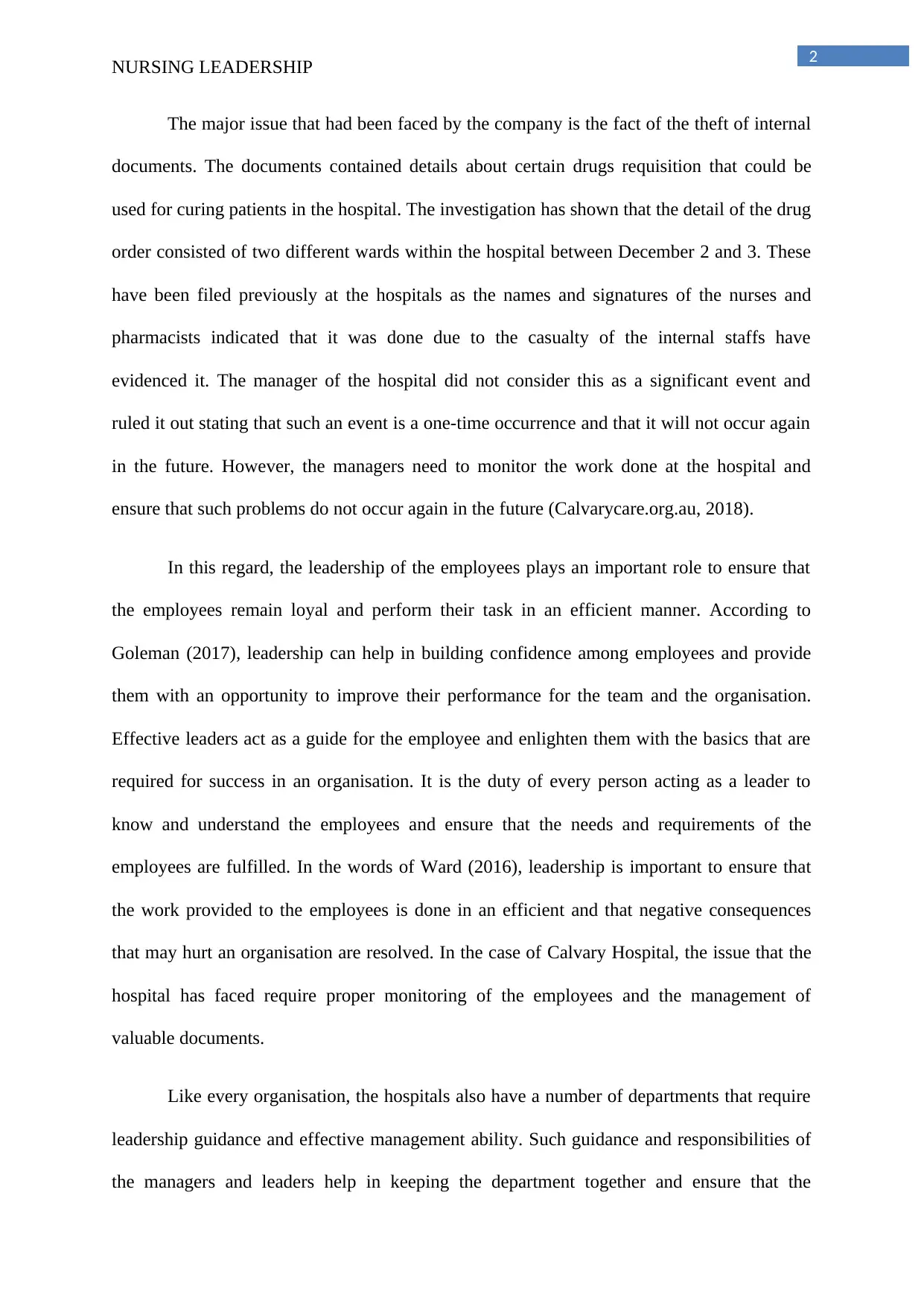
2
NURSING LEADERSHIP
The major issue that had been faced by the company is the fact of the theft of internal
documents. The documents contained details about certain drugs requisition that could be
used for curing patients in the hospital. The investigation has shown that the detail of the drug
order consisted of two different wards within the hospital between December 2 and 3. These
have been filed previously at the hospitals as the names and signatures of the nurses and
pharmacists indicated that it was done due to the casualty of the internal staffs have
evidenced it. The manager of the hospital did not consider this as a significant event and
ruled it out stating that such an event is a one-time occurrence and that it will not occur again
in the future. However, the managers need to monitor the work done at the hospital and
ensure that such problems do not occur again in the future (Calvarycare.org.au, 2018).
In this regard, the leadership of the employees plays an important role to ensure that
the employees remain loyal and perform their task in an efficient manner. According to
Goleman (2017), leadership can help in building confidence among employees and provide
them with an opportunity to improve their performance for the team and the organisation.
Effective leaders act as a guide for the employee and enlighten them with the basics that are
required for success in an organisation. It is the duty of every person acting as a leader to
know and understand the employees and ensure that the needs and requirements of the
employees are fulfilled. In the words of Ward (2016), leadership is important to ensure that
the work provided to the employees is done in an efficient and that negative consequences
that may hurt an organisation are resolved. In the case of Calvary Hospital, the issue that the
hospital has faced require proper monitoring of the employees and the management of
valuable documents.
Like every organisation, the hospitals also have a number of departments that require
leadership guidance and effective management ability. Such guidance and responsibilities of
the managers and leaders help in keeping the department together and ensure that the
NURSING LEADERSHIP
The major issue that had been faced by the company is the fact of the theft of internal
documents. The documents contained details about certain drugs requisition that could be
used for curing patients in the hospital. The investigation has shown that the detail of the drug
order consisted of two different wards within the hospital between December 2 and 3. These
have been filed previously at the hospitals as the names and signatures of the nurses and
pharmacists indicated that it was done due to the casualty of the internal staffs have
evidenced it. The manager of the hospital did not consider this as a significant event and
ruled it out stating that such an event is a one-time occurrence and that it will not occur again
in the future. However, the managers need to monitor the work done at the hospital and
ensure that such problems do not occur again in the future (Calvarycare.org.au, 2018).
In this regard, the leadership of the employees plays an important role to ensure that
the employees remain loyal and perform their task in an efficient manner. According to
Goleman (2017), leadership can help in building confidence among employees and provide
them with an opportunity to improve their performance for the team and the organisation.
Effective leaders act as a guide for the employee and enlighten them with the basics that are
required for success in an organisation. It is the duty of every person acting as a leader to
know and understand the employees and ensure that the needs and requirements of the
employees are fulfilled. In the words of Ward (2016), leadership is important to ensure that
the work provided to the employees is done in an efficient and that negative consequences
that may hurt an organisation are resolved. In the case of Calvary Hospital, the issue that the
hospital has faced require proper monitoring of the employees and the management of
valuable documents.
Like every organisation, the hospitals also have a number of departments that require
leadership guidance and effective management ability. Such guidance and responsibilities of
the managers and leaders help in keeping the department together and ensure that the
⊘ This is a preview!⊘
Do you want full access?
Subscribe today to unlock all pages.

Trusted by 1+ million students worldwide
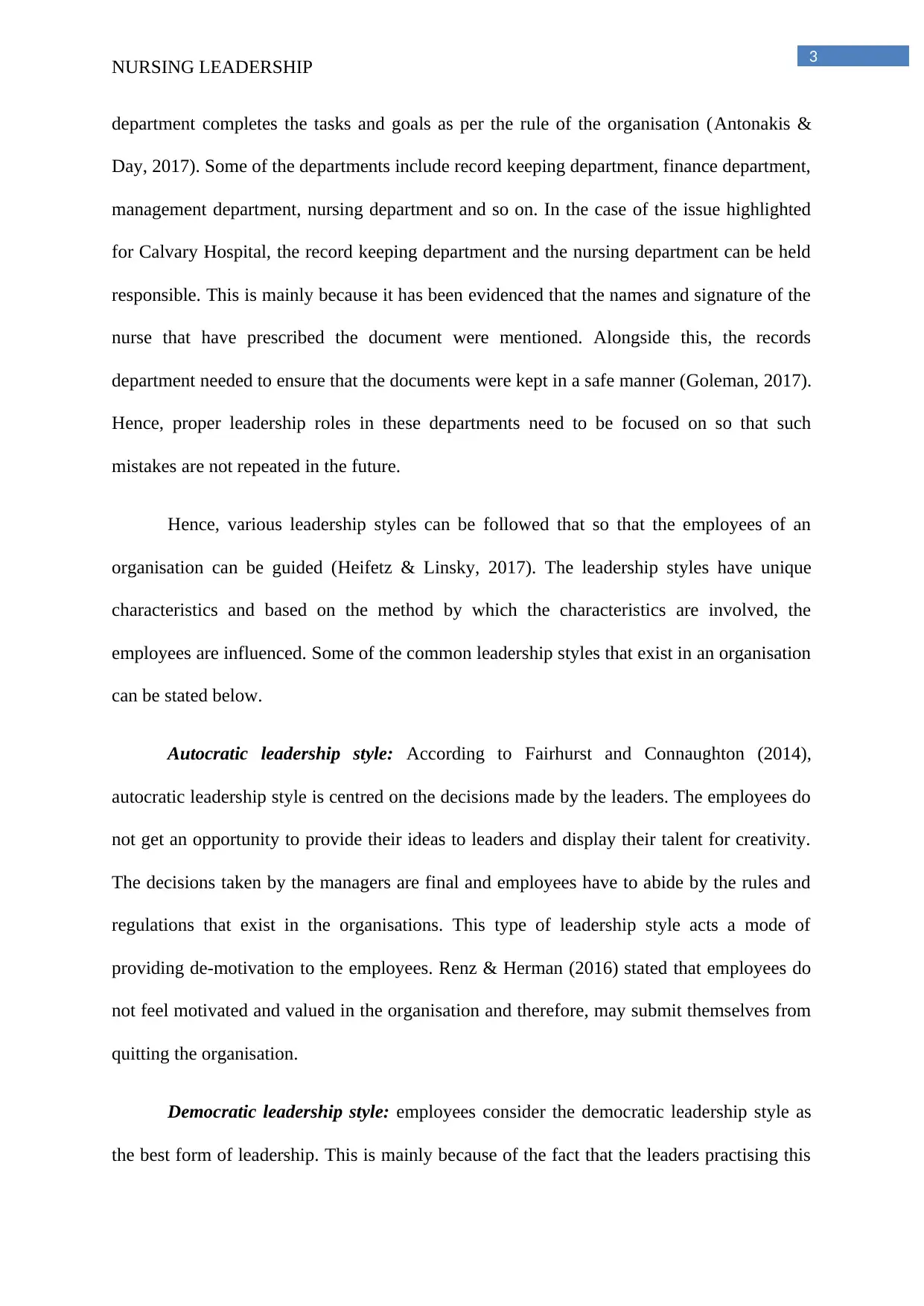
3
NURSING LEADERSHIP
department completes the tasks and goals as per the rule of the organisation (Antonakis &
Day, 2017). Some of the departments include record keeping department, finance department,
management department, nursing department and so on. In the case of the issue highlighted
for Calvary Hospital, the record keeping department and the nursing department can be held
responsible. This is mainly because it has been evidenced that the names and signature of the
nurse that have prescribed the document were mentioned. Alongside this, the records
department needed to ensure that the documents were kept in a safe manner (Goleman, 2017).
Hence, proper leadership roles in these departments need to be focused on so that such
mistakes are not repeated in the future.
Hence, various leadership styles can be followed that so that the employees of an
organisation can be guided (Heifetz & Linsky, 2017). The leadership styles have unique
characteristics and based on the method by which the characteristics are involved, the
employees are influenced. Some of the common leadership styles that exist in an organisation
can be stated below.
Autocratic leadership style: According to Fairhurst and Connaughton (2014),
autocratic leadership style is centred on the decisions made by the leaders. The employees do
not get an opportunity to provide their ideas to leaders and display their talent for creativity.
The decisions taken by the managers are final and employees have to abide by the rules and
regulations that exist in the organisations. This type of leadership style acts a mode of
providing de-motivation to the employees. Renz & Herman (2016) stated that employees do
not feel motivated and valued in the organisation and therefore, may submit themselves from
quitting the organisation.
Democratic leadership style: employees consider the democratic leadership style as
the best form of leadership. This is mainly because of the fact that the leaders practising this
NURSING LEADERSHIP
department completes the tasks and goals as per the rule of the organisation (Antonakis &
Day, 2017). Some of the departments include record keeping department, finance department,
management department, nursing department and so on. In the case of the issue highlighted
for Calvary Hospital, the record keeping department and the nursing department can be held
responsible. This is mainly because it has been evidenced that the names and signature of the
nurse that have prescribed the document were mentioned. Alongside this, the records
department needed to ensure that the documents were kept in a safe manner (Goleman, 2017).
Hence, proper leadership roles in these departments need to be focused on so that such
mistakes are not repeated in the future.
Hence, various leadership styles can be followed that so that the employees of an
organisation can be guided (Heifetz & Linsky, 2017). The leadership styles have unique
characteristics and based on the method by which the characteristics are involved, the
employees are influenced. Some of the common leadership styles that exist in an organisation
can be stated below.
Autocratic leadership style: According to Fairhurst and Connaughton (2014),
autocratic leadership style is centred on the decisions made by the leaders. The employees do
not get an opportunity to provide their ideas to leaders and display their talent for creativity.
The decisions taken by the managers are final and employees have to abide by the rules and
regulations that exist in the organisations. This type of leadership style acts a mode of
providing de-motivation to the employees. Renz & Herman (2016) stated that employees do
not feel motivated and valued in the organisation and therefore, may submit themselves from
quitting the organisation.
Democratic leadership style: employees consider the democratic leadership style as
the best form of leadership. This is mainly because of the fact that the leaders practising this
Paraphrase This Document
Need a fresh take? Get an instant paraphrase of this document with our AI Paraphraser
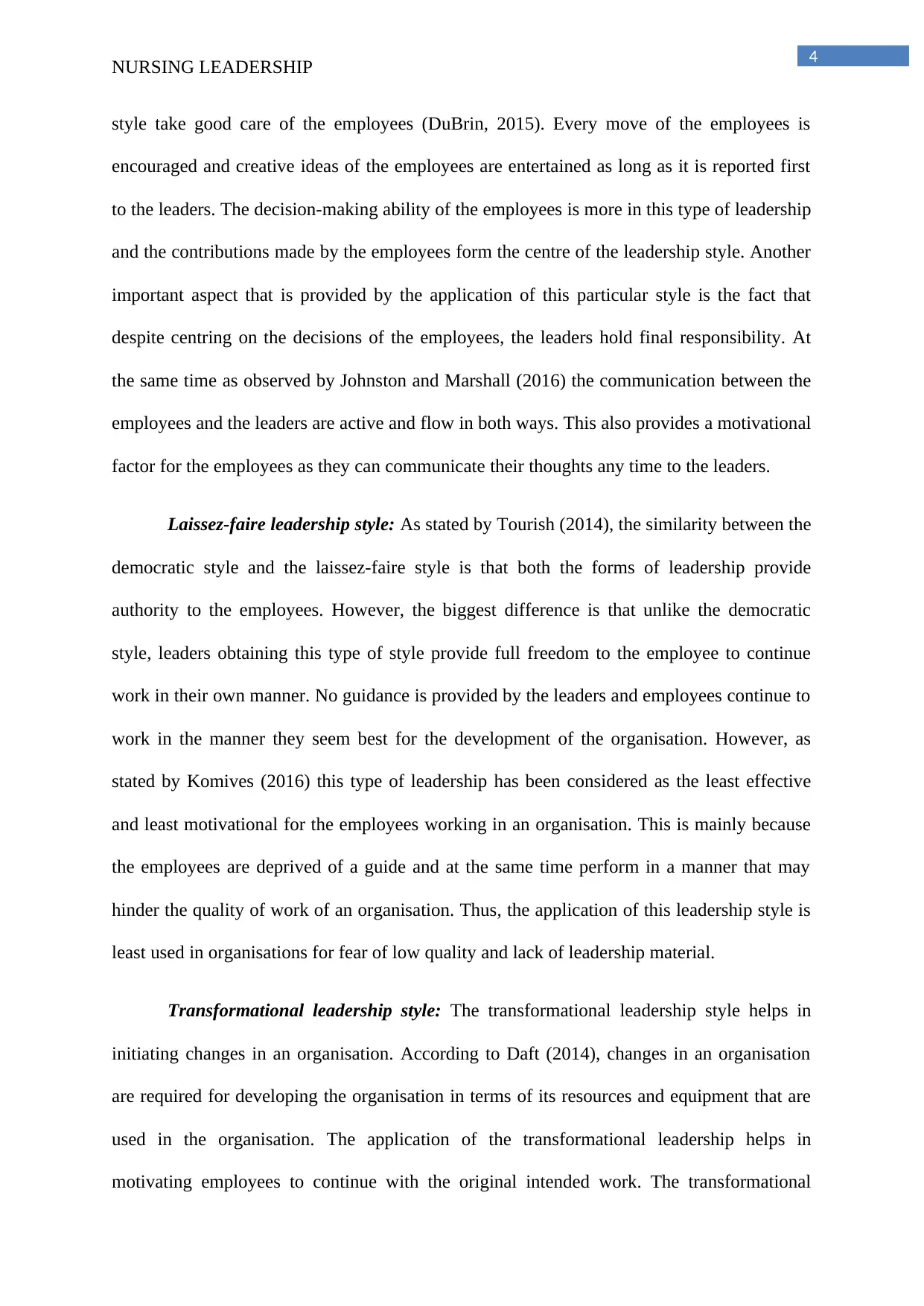
4
NURSING LEADERSHIP
style take good care of the employees (DuBrin, 2015). Every move of the employees is
encouraged and creative ideas of the employees are entertained as long as it is reported first
to the leaders. The decision-making ability of the employees is more in this type of leadership
and the contributions made by the employees form the centre of the leadership style. Another
important aspect that is provided by the application of this particular style is the fact that
despite centring on the decisions of the employees, the leaders hold final responsibility. At
the same time as observed by Johnston and Marshall (2016) the communication between the
employees and the leaders are active and flow in both ways. This also provides a motivational
factor for the employees as they can communicate their thoughts any time to the leaders.
Laissez-faire leadership style: As stated by Tourish (2014), the similarity between the
democratic style and the laissez-faire style is that both the forms of leadership provide
authority to the employees. However, the biggest difference is that unlike the democratic
style, leaders obtaining this type of style provide full freedom to the employee to continue
work in their own manner. No guidance is provided by the leaders and employees continue to
work in the manner they seem best for the development of the organisation. However, as
stated by Komives (2016) this type of leadership has been considered as the least effective
and least motivational for the employees working in an organisation. This is mainly because
the employees are deprived of a guide and at the same time perform in a manner that may
hinder the quality of work of an organisation. Thus, the application of this leadership style is
least used in organisations for fear of low quality and lack of leadership material.
Transformational leadership style: The transformational leadership style helps in
initiating changes in an organisation. According to Daft (2014), changes in an organisation
are required for developing the organisation in terms of its resources and equipment that are
used in the organisation. The application of the transformational leadership helps in
motivating employees to continue with the original intended work. The transformational
NURSING LEADERSHIP
style take good care of the employees (DuBrin, 2015). Every move of the employees is
encouraged and creative ideas of the employees are entertained as long as it is reported first
to the leaders. The decision-making ability of the employees is more in this type of leadership
and the contributions made by the employees form the centre of the leadership style. Another
important aspect that is provided by the application of this particular style is the fact that
despite centring on the decisions of the employees, the leaders hold final responsibility. At
the same time as observed by Johnston and Marshall (2016) the communication between the
employees and the leaders are active and flow in both ways. This also provides a motivational
factor for the employees as they can communicate their thoughts any time to the leaders.
Laissez-faire leadership style: As stated by Tourish (2014), the similarity between the
democratic style and the laissez-faire style is that both the forms of leadership provide
authority to the employees. However, the biggest difference is that unlike the democratic
style, leaders obtaining this type of style provide full freedom to the employee to continue
work in their own manner. No guidance is provided by the leaders and employees continue to
work in the manner they seem best for the development of the organisation. However, as
stated by Komives (2016) this type of leadership has been considered as the least effective
and least motivational for the employees working in an organisation. This is mainly because
the employees are deprived of a guide and at the same time perform in a manner that may
hinder the quality of work of an organisation. Thus, the application of this leadership style is
least used in organisations for fear of low quality and lack of leadership material.
Transformational leadership style: The transformational leadership style helps in
initiating changes in an organisation. According to Daft (2014), changes in an organisation
are required for developing the organisation in terms of its resources and equipment that are
used in the organisation. The application of the transformational leadership helps in
motivating employees to continue with the original intended work. The transformational
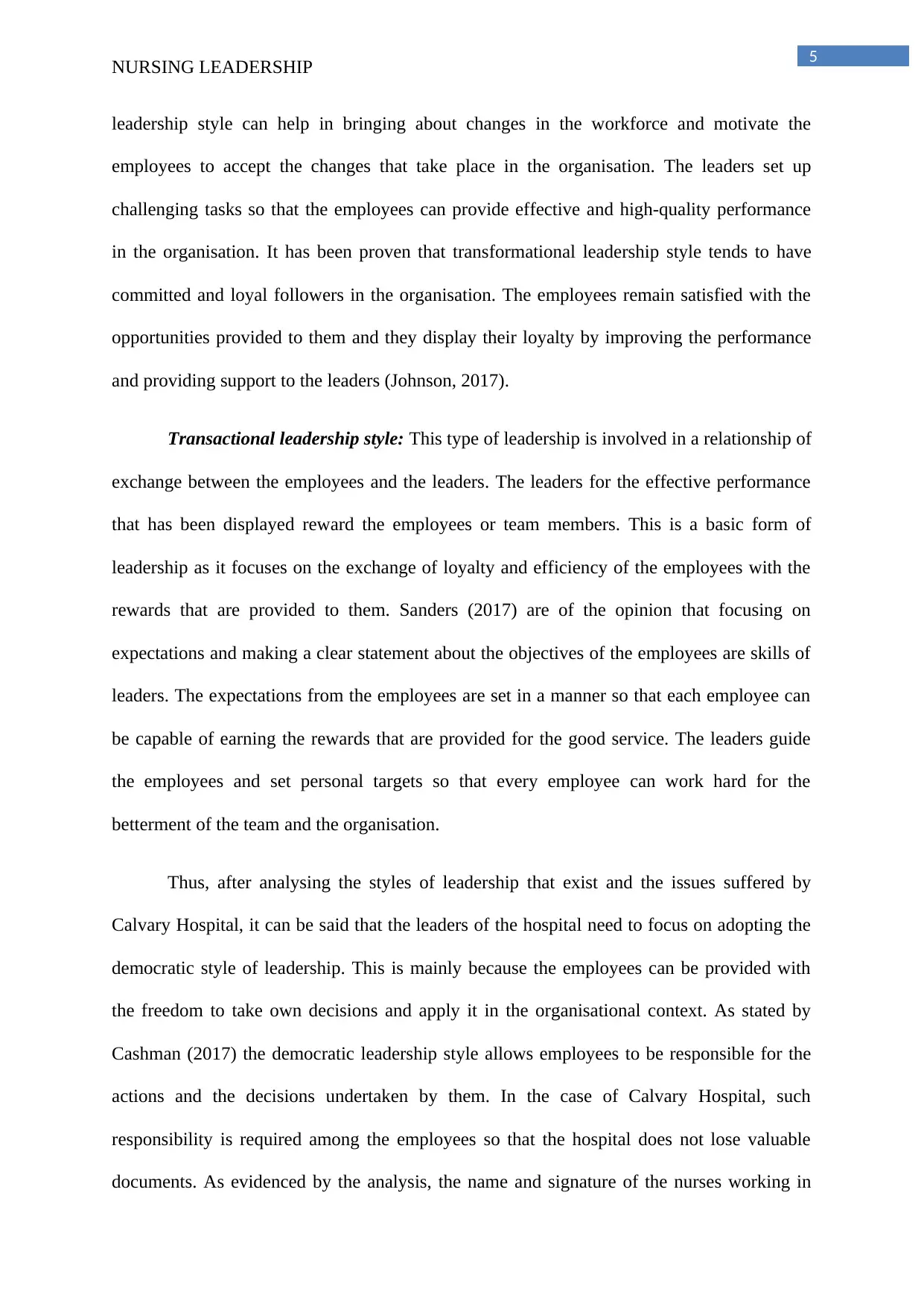
5
NURSING LEADERSHIP
leadership style can help in bringing about changes in the workforce and motivate the
employees to accept the changes that take place in the organisation. The leaders set up
challenging tasks so that the employees can provide effective and high-quality performance
in the organisation. It has been proven that transformational leadership style tends to have
committed and loyal followers in the organisation. The employees remain satisfied with the
opportunities provided to them and they display their loyalty by improving the performance
and providing support to the leaders (Johnson, 2017).
Transactional leadership style: This type of leadership is involved in a relationship of
exchange between the employees and the leaders. The leaders for the effective performance
that has been displayed reward the employees or team members. This is a basic form of
leadership as it focuses on the exchange of loyalty and efficiency of the employees with the
rewards that are provided to them. Sanders (2017) are of the opinion that focusing on
expectations and making a clear statement about the objectives of the employees are skills of
leaders. The expectations from the employees are set in a manner so that each employee can
be capable of earning the rewards that are provided for the good service. The leaders guide
the employees and set personal targets so that every employee can work hard for the
betterment of the team and the organisation.
Thus, after analysing the styles of leadership that exist and the issues suffered by
Calvary Hospital, it can be said that the leaders of the hospital need to focus on adopting the
democratic style of leadership. This is mainly because the employees can be provided with
the freedom to take own decisions and apply it in the organisational context. As stated by
Cashman (2017) the democratic leadership style allows employees to be responsible for the
actions and the decisions undertaken by them. In the case of Calvary Hospital, such
responsibility is required among the employees so that the hospital does not lose valuable
documents. As evidenced by the analysis, the name and signature of the nurses working in
NURSING LEADERSHIP
leadership style can help in bringing about changes in the workforce and motivate the
employees to accept the changes that take place in the organisation. The leaders set up
challenging tasks so that the employees can provide effective and high-quality performance
in the organisation. It has been proven that transformational leadership style tends to have
committed and loyal followers in the organisation. The employees remain satisfied with the
opportunities provided to them and they display their loyalty by improving the performance
and providing support to the leaders (Johnson, 2017).
Transactional leadership style: This type of leadership is involved in a relationship of
exchange between the employees and the leaders. The leaders for the effective performance
that has been displayed reward the employees or team members. This is a basic form of
leadership as it focuses on the exchange of loyalty and efficiency of the employees with the
rewards that are provided to them. Sanders (2017) are of the opinion that focusing on
expectations and making a clear statement about the objectives of the employees are skills of
leaders. The expectations from the employees are set in a manner so that each employee can
be capable of earning the rewards that are provided for the good service. The leaders guide
the employees and set personal targets so that every employee can work hard for the
betterment of the team and the organisation.
Thus, after analysing the styles of leadership that exist and the issues suffered by
Calvary Hospital, it can be said that the leaders of the hospital need to focus on adopting the
democratic style of leadership. This is mainly because the employees can be provided with
the freedom to take own decisions and apply it in the organisational context. As stated by
Cashman (2017) the democratic leadership style allows employees to be responsible for the
actions and the decisions undertaken by them. In the case of Calvary Hospital, such
responsibility is required among the employees so that the hospital does not lose valuable
documents. As evidenced by the analysis, the name and signature of the nurses working in
⊘ This is a preview!⊘
Do you want full access?
Subscribe today to unlock all pages.

Trusted by 1+ million students worldwide
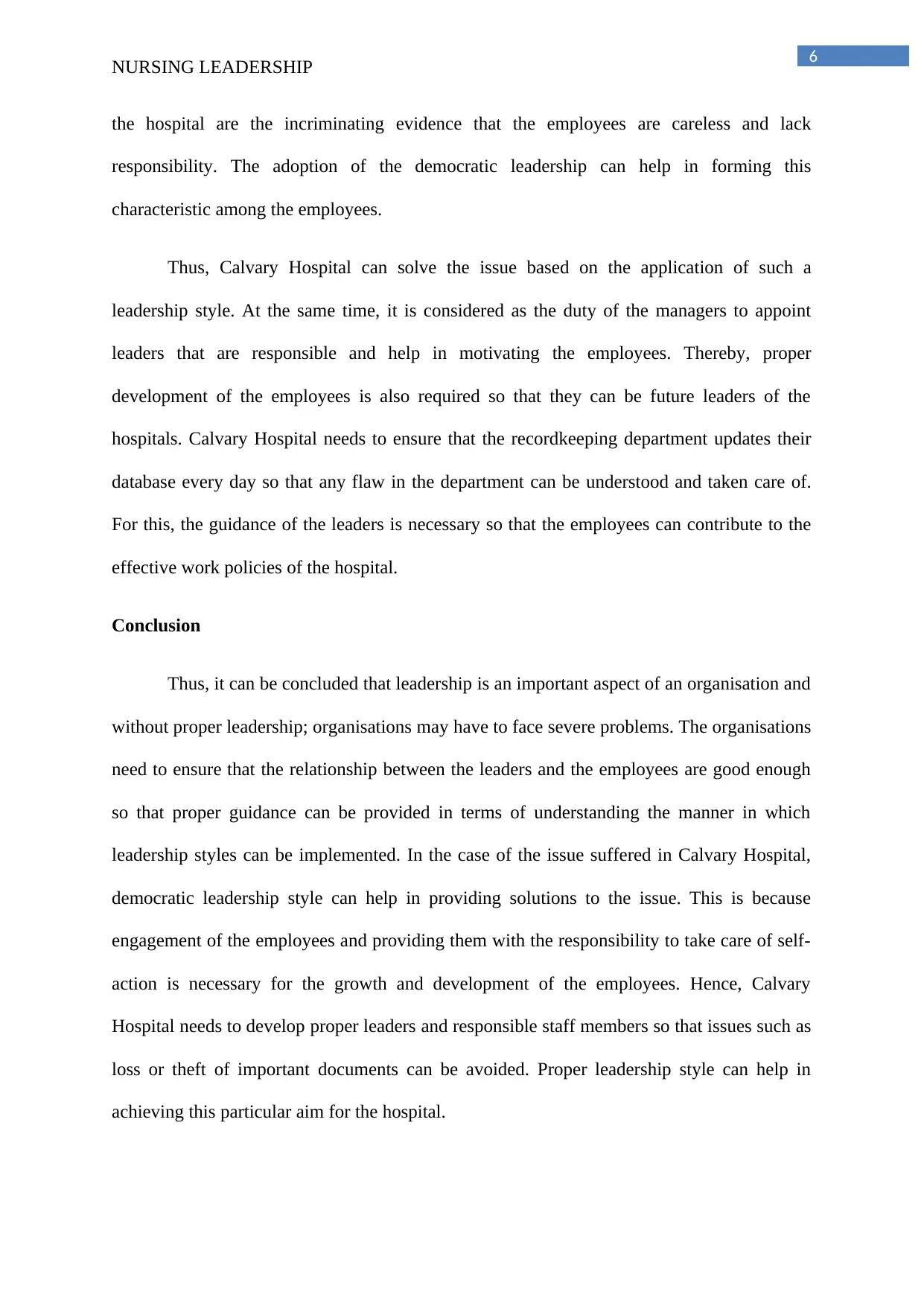
6
NURSING LEADERSHIP
the hospital are the incriminating evidence that the employees are careless and lack
responsibility. The adoption of the democratic leadership can help in forming this
characteristic among the employees.
Thus, Calvary Hospital can solve the issue based on the application of such a
leadership style. At the same time, it is considered as the duty of the managers to appoint
leaders that are responsible and help in motivating the employees. Thereby, proper
development of the employees is also required so that they can be future leaders of the
hospitals. Calvary Hospital needs to ensure that the recordkeeping department updates their
database every day so that any flaw in the department can be understood and taken care of.
For this, the guidance of the leaders is necessary so that the employees can contribute to the
effective work policies of the hospital.
Conclusion
Thus, it can be concluded that leadership is an important aspect of an organisation and
without proper leadership; organisations may have to face severe problems. The organisations
need to ensure that the relationship between the leaders and the employees are good enough
so that proper guidance can be provided in terms of understanding the manner in which
leadership styles can be implemented. In the case of the issue suffered in Calvary Hospital,
democratic leadership style can help in providing solutions to the issue. This is because
engagement of the employees and providing them with the responsibility to take care of self-
action is necessary for the growth and development of the employees. Hence, Calvary
Hospital needs to develop proper leaders and responsible staff members so that issues such as
loss or theft of important documents can be avoided. Proper leadership style can help in
achieving this particular aim for the hospital.
NURSING LEADERSHIP
the hospital are the incriminating evidence that the employees are careless and lack
responsibility. The adoption of the democratic leadership can help in forming this
characteristic among the employees.
Thus, Calvary Hospital can solve the issue based on the application of such a
leadership style. At the same time, it is considered as the duty of the managers to appoint
leaders that are responsible and help in motivating the employees. Thereby, proper
development of the employees is also required so that they can be future leaders of the
hospitals. Calvary Hospital needs to ensure that the recordkeeping department updates their
database every day so that any flaw in the department can be understood and taken care of.
For this, the guidance of the leaders is necessary so that the employees can contribute to the
effective work policies of the hospital.
Conclusion
Thus, it can be concluded that leadership is an important aspect of an organisation and
without proper leadership; organisations may have to face severe problems. The organisations
need to ensure that the relationship between the leaders and the employees are good enough
so that proper guidance can be provided in terms of understanding the manner in which
leadership styles can be implemented. In the case of the issue suffered in Calvary Hospital,
democratic leadership style can help in providing solutions to the issue. This is because
engagement of the employees and providing them with the responsibility to take care of self-
action is necessary for the growth and development of the employees. Hence, Calvary
Hospital needs to develop proper leaders and responsible staff members so that issues such as
loss or theft of important documents can be avoided. Proper leadership style can help in
achieving this particular aim for the hospital.
Paraphrase This Document
Need a fresh take? Get an instant paraphrase of this document with our AI Paraphraser
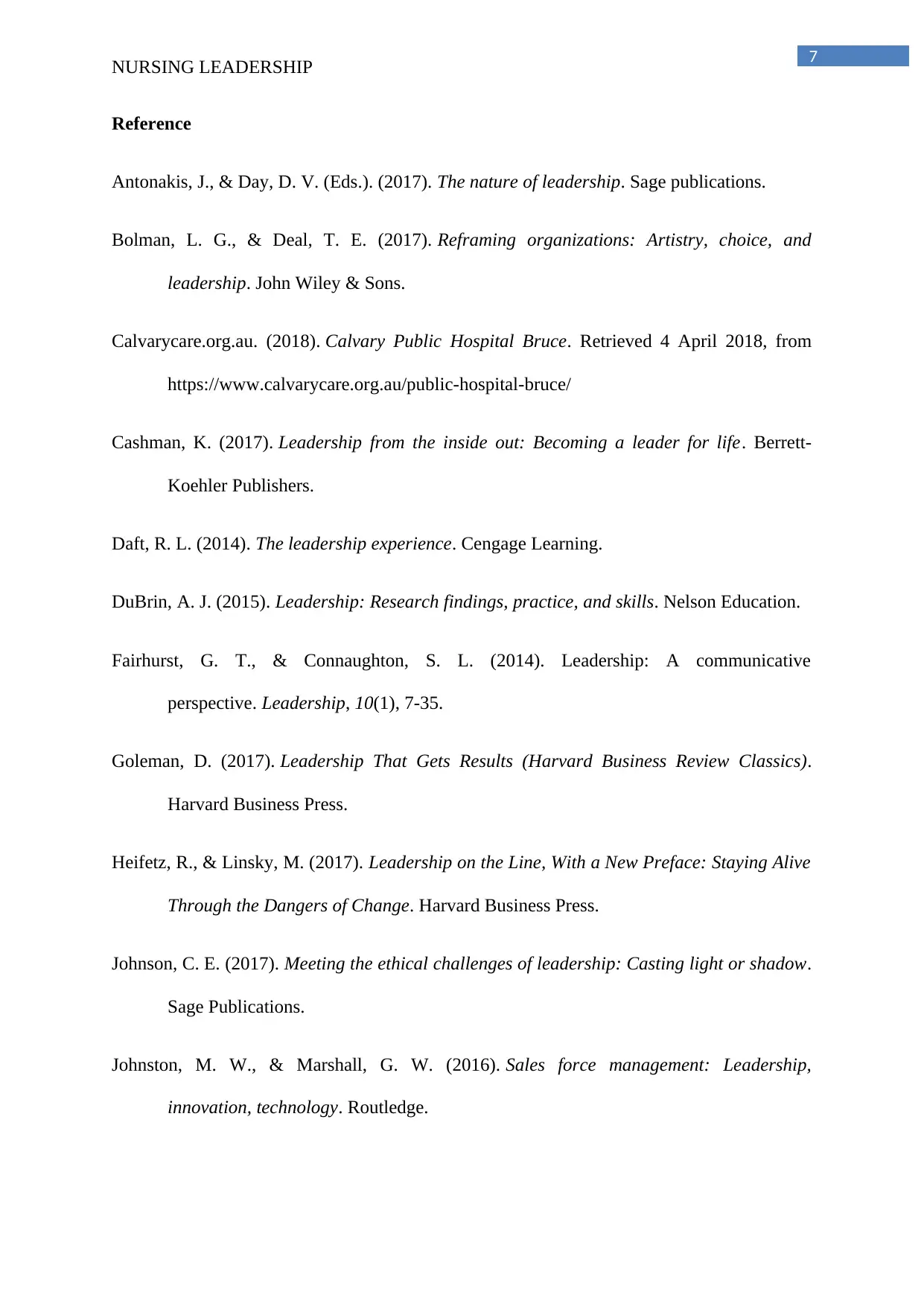
7
NURSING LEADERSHIP
Reference
Antonakis, J., & Day, D. V. (Eds.). (2017). The nature of leadership. Sage publications.
Bolman, L. G., & Deal, T. E. (2017). Reframing organizations: Artistry, choice, and
leadership. John Wiley & Sons.
Calvarycare.org.au. (2018). Calvary Public Hospital Bruce. Retrieved 4 April 2018, from
https://www.calvarycare.org.au/public-hospital-bruce/
Cashman, K. (2017). Leadership from the inside out: Becoming a leader for life. Berrett-
Koehler Publishers.
Daft, R. L. (2014). The leadership experience. Cengage Learning.
DuBrin, A. J. (2015). Leadership: Research findings, practice, and skills. Nelson Education.
Fairhurst, G. T., & Connaughton, S. L. (2014). Leadership: A communicative
perspective. Leadership, 10(1), 7-35.
Goleman, D. (2017). Leadership That Gets Results (Harvard Business Review Classics).
Harvard Business Press.
Heifetz, R., & Linsky, M. (2017). Leadership on the Line, With a New Preface: Staying Alive
Through the Dangers of Change. Harvard Business Press.
Johnson, C. E. (2017). Meeting the ethical challenges of leadership: Casting light or shadow.
Sage Publications.
Johnston, M. W., & Marshall, G. W. (2016). Sales force management: Leadership,
innovation, technology. Routledge.
NURSING LEADERSHIP
Reference
Antonakis, J., & Day, D. V. (Eds.). (2017). The nature of leadership. Sage publications.
Bolman, L. G., & Deal, T. E. (2017). Reframing organizations: Artistry, choice, and
leadership. John Wiley & Sons.
Calvarycare.org.au. (2018). Calvary Public Hospital Bruce. Retrieved 4 April 2018, from
https://www.calvarycare.org.au/public-hospital-bruce/
Cashman, K. (2017). Leadership from the inside out: Becoming a leader for life. Berrett-
Koehler Publishers.
Daft, R. L. (2014). The leadership experience. Cengage Learning.
DuBrin, A. J. (2015). Leadership: Research findings, practice, and skills. Nelson Education.
Fairhurst, G. T., & Connaughton, S. L. (2014). Leadership: A communicative
perspective. Leadership, 10(1), 7-35.
Goleman, D. (2017). Leadership That Gets Results (Harvard Business Review Classics).
Harvard Business Press.
Heifetz, R., & Linsky, M. (2017). Leadership on the Line, With a New Preface: Staying Alive
Through the Dangers of Change. Harvard Business Press.
Johnson, C. E. (2017). Meeting the ethical challenges of leadership: Casting light or shadow.
Sage Publications.
Johnston, M. W., & Marshall, G. W. (2016). Sales force management: Leadership,
innovation, technology. Routledge.
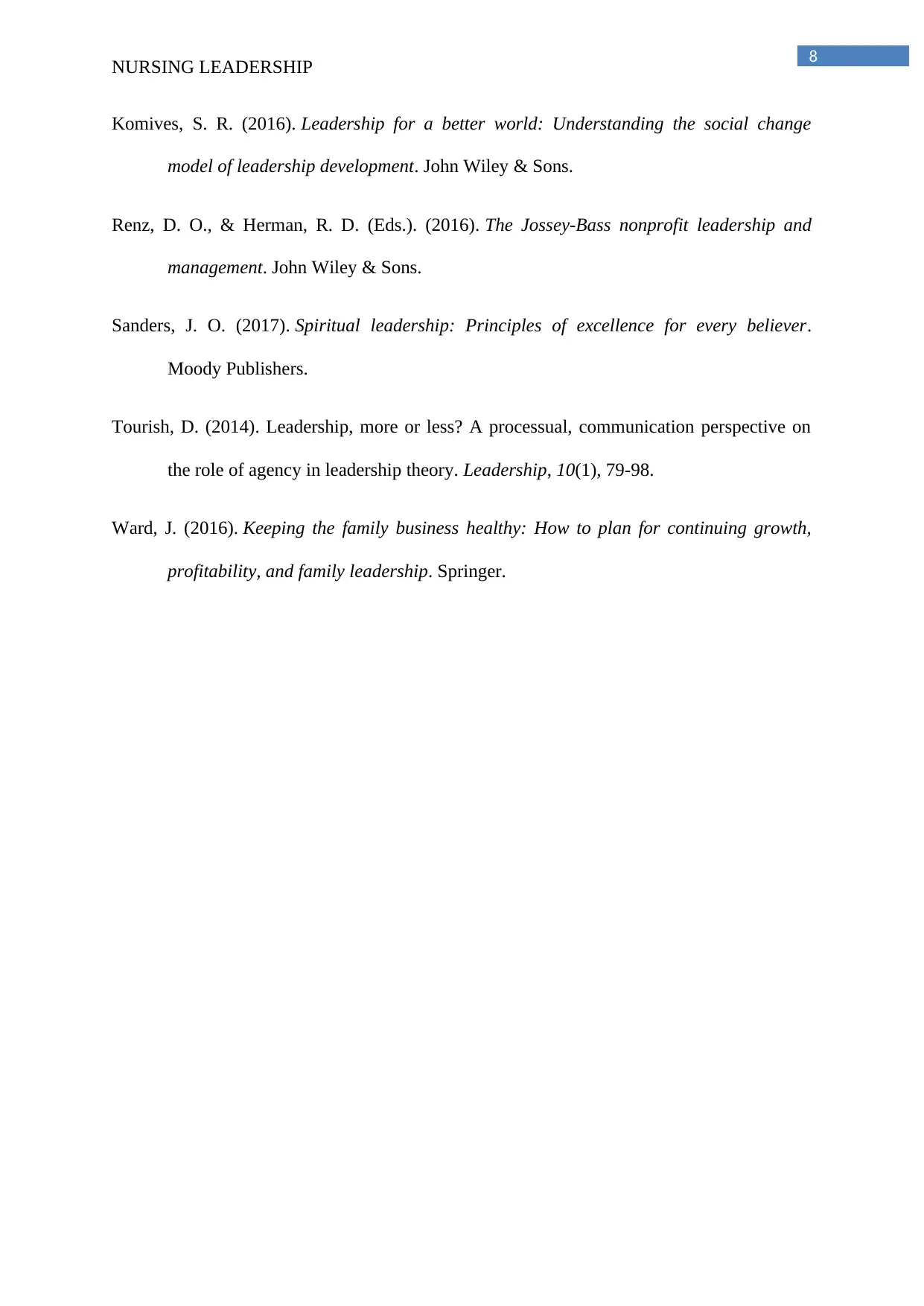
8
NURSING LEADERSHIP
Komives, S. R. (2016). Leadership for a better world: Understanding the social change
model of leadership development. John Wiley & Sons.
Renz, D. O., & Herman, R. D. (Eds.). (2016). The Jossey-Bass nonprofit leadership and
management. John Wiley & Sons.
Sanders, J. O. (2017). Spiritual leadership: Principles of excellence for every believer.
Moody Publishers.
Tourish, D. (2014). Leadership, more or less? A processual, communication perspective on
the role of agency in leadership theory. Leadership, 10(1), 79-98.
Ward, J. (2016). Keeping the family business healthy: How to plan for continuing growth,
profitability, and family leadership. Springer.
NURSING LEADERSHIP
Komives, S. R. (2016). Leadership for a better world: Understanding the social change
model of leadership development. John Wiley & Sons.
Renz, D. O., & Herman, R. D. (Eds.). (2016). The Jossey-Bass nonprofit leadership and
management. John Wiley & Sons.
Sanders, J. O. (2017). Spiritual leadership: Principles of excellence for every believer.
Moody Publishers.
Tourish, D. (2014). Leadership, more or less? A processual, communication perspective on
the role of agency in leadership theory. Leadership, 10(1), 79-98.
Ward, J. (2016). Keeping the family business healthy: How to plan for continuing growth,
profitability, and family leadership. Springer.
⊘ This is a preview!⊘
Do you want full access?
Subscribe today to unlock all pages.

Trusted by 1+ million students worldwide
1 out of 9
Related Documents
Your All-in-One AI-Powered Toolkit for Academic Success.
+13062052269
info@desklib.com
Available 24*7 on WhatsApp / Email
![[object Object]](/_next/static/media/star-bottom.7253800d.svg)
Unlock your academic potential
Copyright © 2020–2025 A2Z Services. All Rights Reserved. Developed and managed by ZUCOL.





